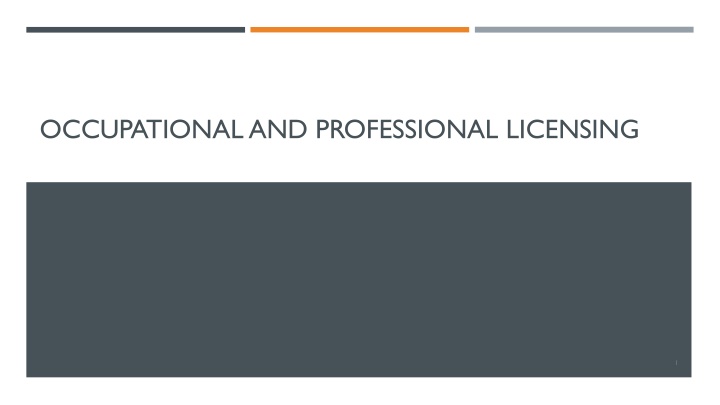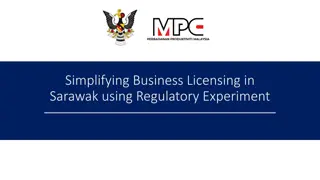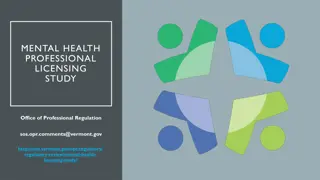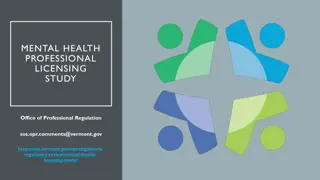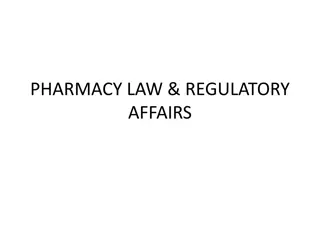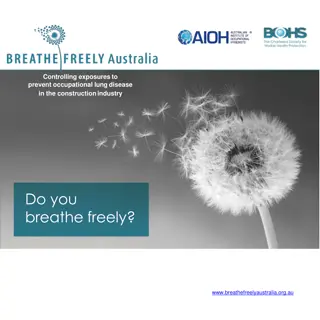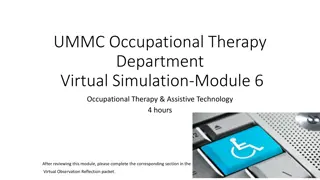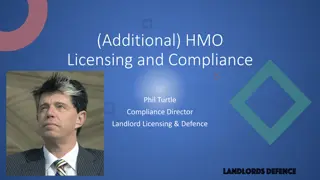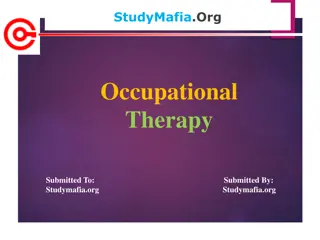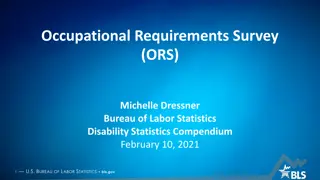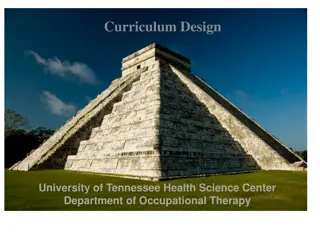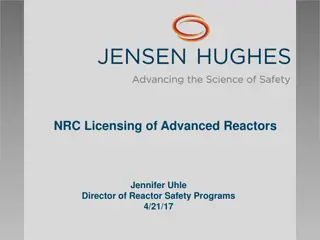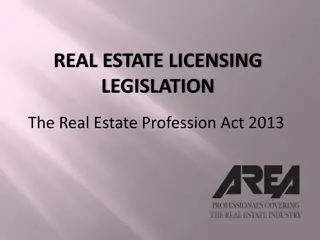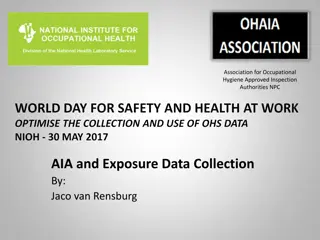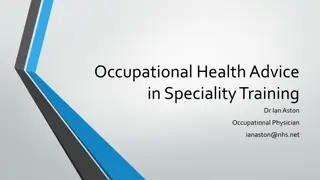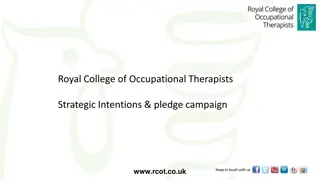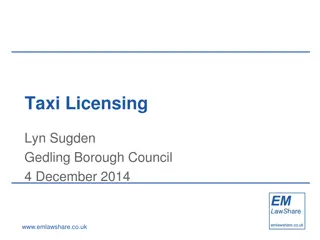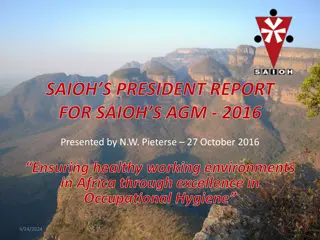OCCUPATIONAL AND PROFESSIONAL LICENSING
This presentation provides an overview of occupational and professional licensing, covering terminology, historical developments, and different types of regulation such as licensing, certification, and registration. It delves into the importance of government credentials, the distinctions between certification and licensing, and the historical context of licensing systems. The guild system of the Middle Ages is also examined as a precursor to modern regulations.
Download Presentation

Please find below an Image/Link to download the presentation.
The content on the website is provided AS IS for your information and personal use only. It may not be sold, licensed, or shared on other websites without obtaining consent from the author.If you encounter any issues during the download, it is possible that the publisher has removed the file from their server.
You are allowed to download the files provided on this website for personal or commercial use, subject to the condition that they are used lawfully. All files are the property of their respective owners.
The content on the website is provided AS IS for your information and personal use only. It may not be sold, licensed, or shared on other websites without obtaining consent from the author.
E N D
Presentation Transcript
INTRODUCTION DEREK R. SLAGLE, PH.D. 2
PRESENTATION OVERVIEW Defining Terminology Past: Historical Overview Present: Literature Review Future: Next Steps 3
3 Types of Occupational Regulation Synonymous Licensing Certification Registration Used interchangeably Do not differentiate in reporting Cannot differentiate in data differences for certification & licensing 5
LICENSING Government credentials required of workers in certain occupations Some universally licensed E.g., Physicians, Lawyers Some licensed only in certain states State legislatures set licensing policies authorize state agencies and regulatory boards to oversee licensing applicants & workforce compliance 7
CERTIFICATION Voluntary Certificates Provided upon exam completion Demonstration of requisite skills/ knowledge Certified individuals can use designated title 8
REGISTRATION Right-to-title Restricts use of profession s title to those certified Anyone can perform duties of profession whether certified or not Registration with state governmental agency is required of certain occupations before occupational practice. Occasionally, requires a surety bond or fee before undertaking professional work Popular alternative to licensing Appropriateness dependent upon if public likely to make improper or dangerous decisions 9
HISTORICAL DEVELOPMENT PAST 10
MIDDLE AGES: THE GUILD SYSTEM 2 Types: Merchants & Craftsmen Primary mechanisms of economic control & regulation Established protection against competition Controller of occupation entry Strict standards of practice Medieval guild systems functioned very similarly to modern professional practices Guild rules + Local Laws Limited number of students in training under Master Length of training for apprentices Controlled wages, hours, working conditions 11
ORIGINS IN AMERICA Early 1800s Early 1900s 1800: Resurgence for medical professions 14/16 states E.g., physicians, dentists, pharmacists Medical boards Medical societies bolster stature of profession in public image Challenges: Societal authority over individuals Economic tool Cooperation with state in regulation of members Rather than protection from incompetent practitioners Licensing diminished More favorable view 12 Medical degrees > Licenses
PROGRESSIVE ERA: 1920S-1950S Argument: Improve markets New specializations, knowledge, & technology Difficulty for consumers to gauge quality Licensing rarely imposed on occupation without its wishes 1950s: <5 % of workforce 13
UNIONIZATION VS LICENSING: SIMILAR BUT DIFFERENT Similarities Differences 1. Similar Effects on Wages 1. Distinction between licensing & union effects 10-15% increase for licensed or unionized Union bargaining wages reallocated profit from shareholders to workers to workers reduce income variation 2. Proportion (density) of labor force 30% at respective peaks Occupational Licensing transfers income from consumers (through higher prices) to licensed workers (in form of higher wages) 3. Possibility of coverage cessation No explicit impact on reducing wage variations 2. Union density peaked 50 years ago Unionization steadily decreasing; Licenses increasing 14 3. Ease of union decertification vs De-licensing efforts
WHY HAS LICENSING INCREASED? 1. Changes in composition of workforce Percent Licensed Over Time: Estimated & Counterfactual Economy shifted since 1950s Employment shifted into services (more likely to be licensed) 1/3 Rather than goods-producing sector Growing share of workers in heavily licensed occupations 2/3 2. More occupations have become licensed over time Licensing expanded considerably into sectors that weren t historically associated 16
SHARE OF ALL LICENSED WORKERS IN 12 OCCUPATIONS WITH MOST LICENSED WORKERS 17
LITERATURE REVIEW PRESENT/ CURRENT TRENDS, ANALYSIS, THEMES 18
OVERVIEW OF LITERATURE: NATIONAL & ARKANSAS Scope Pros & Cons Vulnerable Populations Workforce Migration Sunset and/or Sunrise Legislation De-Licensing Efforts 19
SCOPE 1993: 600 occupations in at least 1 state Early 2000s: 800 occupations in at least 1 state 50 occupations listed in all states 20% of workforce 2017: 1,100 occupations in at least 1 state <60 occupations listed in all states 25% of workforce 20
SCOPE: ARKANSAS 86 Licensing/ Certifying Boards and Agencies Providing 305 different licenses, certifications, and registrations Cover approximately 651 careers (US Department of Labor, 2017) % to be discussed 21
US DEPARTMENT OF LABOR, CAREERSTOP CREDENTIALS CENTER: ARKANSAS LICENSED OCCUPATIONS BY CATEGORY (2017) Architecture & Engineering Arts, Design, Entertainment, Sports, & Media Building & Grounds Cleaning & Maintenance Business & Financial Operations 50 20 Healthcare Support 17 Installation, Maintenance, & Repair 37 Legal 6 8 Life, Physical, & Social Science 40 41 Management 39 Office & Administrative Support 26 Community & Social Service Computer & Mathematical Construction & Extraction Education, Training, & Library Farming, Fishing, & Forestry Food Preparation & Service Related Healthcare Practitioners & Technical 16 3 52 36 14 16 84 Personal Care & Service 30 Production 34 Protective Services 23 Sales & Related 23 22 Transportation & Material Moving 36
PERCENT OF WORKFORCE LICENSED FOR ARKANSAS (KLEINER, 2006 USING 2000 CENSUS DATA) Total Percentage of Workers: 345,360 licensed workers in state /1,209,260 total workers in state = 28.56% of all workers Average state percentage: 19.9% Number of licensed occupations: 140 for Arkansas 3rd worst 24
PERCENT OF WORKFORCE LICENSED BY STATE (2015) (1) Iowa (2) Nevada (3) Washington 30.5% (4) Kentucky [ ] (19-tie) Tennessee (19-tie) Mississippi (22)Louisiana (26) Missouri [ ] (35-tie) Arkansas 20.2% [ ] (51) S. Carolina 30.3% 30.7% 27.8% 23.1% 23.1% 22.3% 21.3% 25 12.4%
ARKANSAS LICENSED OCCUPATIONS BY THE NUMBERS Most Licensed Occupations Heavy and Tractor-Trailer Truck Drivers Least Licensed Occupations Meeting, Convention, & Event Planners 3 3 7 19 139,688 Sales Agents, Securities & Commodities 108,924 Forest & Conservation Workers Insurance Sales Agents 87,070 Agricultural Inspectors Office & Administrative Support Workers, All Other (Notary Public) Training & Development Specialists Total 51,000 Lead-based Paint Abatement Training Provider 1 Registered Nurses 39,468 Asbestos Training Provider 18 23 27 29 Kindergarten & Elementary School Teachers, Except Special Education Graders & Sorters, Agricultural Products 34,540 Midwives Nursing Assistants 30,327 Acupuncturists Secondary School Teachers 30,000 Public Address System & Other Announcers: Ring Announcers Middle School Teachers 24,405 26 30 Construction Managers 19,486
POTENTIAL PROS Improve quality Protect public health & safety Consumer information on service quality Benefit practitioners Encourage individuals to invest in lifelong occupational skills Professionalization & Standardization Creation of career paths for licensed workers Improved pay State s affiliation Legitimacy & prestige Build community & cohesiveness within occupation 27 Licensing boards revenue neutral or revenue generating
POTENTIAL CONS Restricts mobility across states (hurdles, costs, & variance) Increases costs of goods & services to consumers Licensing reduces employment/ competition in licensed occupations higher prices Reduce access to jobs in licensed occupations Barriers to workers makes labor market less efficient can limit economic growth Licensing affects who takes what job Wages & Employment lower for unlicensed Burdens on employers/ workers Inconsistent, inefficient, arbitrary systems of licensing High costs to individuals: training, education, fees, paperwork Inhibits self-employment & innovation Most research does not find that licensing improves quality or public health & safety 28
Balancing Act: Costs & Benefits Do Benefits Outweigh Risks? 29
VULNERABLE POPULATIONS Military Military Spouses Immigrants Blanket exclusions for formerly incarcerated or with criminal records Low-&-Middle Income Workers; No-or-Little education workers Impact on a lot of blue collar jobs 30
IMPACTED POPULATIONS: MILITARY AND MILITARY SPOUSES Highly mobile 35% military spouses in occupations that requires licenses Frequently relocate across state lines 10x 31
IMPACTED POPULATIONS: CONVICTS Nationally: Approx. 1/3 Americans have some form of criminal record (70-100 million) Arrest or Conviction Ineligible for large share of jobs perpetuating unstable, individual economic situations Licensing laws often contain blanket exclusions for formerly incarcerated or criminal records Understandable that some types of criminal convictions should disqualify applicants for certain jobs Relevancy boards Often take 6 months - 1 year to review applications Arkansas has standards/ relevancy board in place* 32
STANDARDS GOVERNING RELEVANCE OF CONVICTION RECORDS OF APPLICANTS FOR OCCUPATIONAL LICENSURE 33
IMPACTED POPULATIONS: IMMIGRANTS Cannot apply skills to U.S. jobs since do not meet relevant licensing requirements Individuals with considerable education, training, & work experience abroad of immigrants with bachelor s degree overqualified for current job (Hall et al., 2011) Training & experience elsewhere do not count 34
IMPACTED POPULATIONS: LOW-AND-MIDDLE INCOME; EDUCATION 35
AVERAGE EDUCATION OR EXPERIENCE (IN DAYS) REQUIRED FOR LICENSE BY STATE FOR SELECTED OCCUPATIONS (2012) (1) Hawaii (2) Arkansas (3) Florida (4) Nevada [ ] (33) Tennessee (34) Missouri (44) Louisiana (45) Mississippi [ ] 49. North Dakota 50. Pennsylvania 724 689 603 601 222 220 163 163 132 113 36
BURDENSOME LICENSING REQUIREMENTS (LICENSE TO WORK, 2017) Study examined requirements for 102 lower income occupations for all 50 states Arkansas licensed 72/102 Average cost of $246 in fees 642 days of education & experience About 1 exam Arkansas 6th most burdensome state with licensing laws High average experience & education burdens 3rd most broadly & onerously licensed state 37
PERSONAL & ECONOMIC FREEDOM (RUGERS & SORENS, 2013) Economic freedom score Only slightly negative Occupational freedom Limited Extent of licensure Standard deviation worse than nat l avg. Education & Experience requirements particularly onerous 38
LICENSING & WORKFORCE MOBILITY Research: More restrictive State licensing statutes reduce migration State-to-state Within-state migration little impact Analysis shows that licensed workers who relocate are 24% less likely than unlicensed workers to move across state lines Diminished mobility inefficiencies in labor market Workers unable to move to jobs they are most productive at 39
DIFFERENCE IN MIGRATION RATES OF WORKERS FOR MOST VS. LEAST LICENSED OCCUPATIONS Most licensed occupation 14% lower for migration than average least- licensed occupations 20% difference 40
DISTANCE LEARNING & REMOTE WORK Remote Work Distance Learning Telework offers important opportunities for licensed practitioners and clients Licensure can be barrier to growth & development Some States are starting to adapt licensing requirements for telework (mainly healthcare & emergency mgt.) Some practitioners need licenses in every state Jurisdictions? Distance education dramatic growth Particularly utilized by professionals for continuing education Occupational licensing boards may restrict participation in distance education Additional accreditation steps for students 42
SCOPE OF PRACTICE Not only if practitioner can practice but what services provided as part of practice Scope of Practice laws vary from state to state Even though nationwide education standards and examinations Vary for complementary & sometimes overlapping or competing services E.g.: Dentists & Dental Hygienists; Doctors & Advanced Practice Nurses; Architects & Interior Designers; Engineers & Architects; Electricians & Electrical Engineers 43
SUNRISE OR SUNSET REVIEWS/LEGISLATION Sunrise or Sunset reviews of occupational licensure Typically Cost-Benefit Analysis Sunset provisions clauses embedded in legislation; expiration dates; Legislative Executive Literature: Sunrise more successful at limiting growth than Sunset are at removing unnecessary licenses Sunset committees usually recommend continuation of licensing Rarely repeal licenses When recommend repeal Legislatures usually ignore rec. Sunset reviews Adapt licensing over time; review complaints lodged w/ board; value of license Practitioners not consumers usually file complaints 44
DE-LICENSING EFFORTS 8 instances of de-licensing 4 over past 40 years 46
SEEMINGLY BIPARTISAN ISSUE Obama Administration U.S. Congress Trump Administration 48
RECOMMENDATIONS FOR SYSTEMATIZATION & HARMONIZATION OF OCCUPATIONAL LICENSING REGULATION (KLEINER, 2015) Cost-Benefit Analysis to Evaluate Occupational Licensing: State governments in coordination with occupational associations, should perform analyses on new and existing regulations for occupational licensing. State Reciprocity: State reciprocity agreements for acceptance of occupational licenses by other states with similar requirements for licensing. Federal Engagement to Promote Best Practices: Certification Policies as a Substitute for Licensing: When costs of licensing exceed benefits, states would consider transferring away from licensing to lesser forms of regulation (see Table 1), or even no regulation at all. The federal government would establish a federal interagency group to promote best practices for occupational regulation. States would then be encouraged to apply for federal grants for evaluation and improvement for occupational licensing systems. 49
BEST PRACTICE RECOMMENDATIONS (2017): DEPARTMENT OF TREASURY OFFICE OF ECONOMIC POLICY; COUNCIL OF ECONOMIC ADVISORS; DEPARTMENT OF LABOR 3. Harmonize regulatory requirement across states, as much as possible 1. Limiting licensing requirements To those that address legitimate public health & safety concerns When appropriate enter into inter-State compacts that recognize licenses from other states to increase mobility of skilled workers Ease burden of licensing on workers 2. Apply results of cost-benefit assessments 4. Allow practitioners to offer services to full extent of current competency To reduce number of unnecessary or overly-restrictive licenses Ensure qualified workers are able to offer services 50
